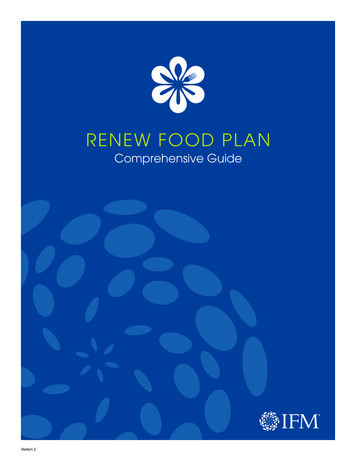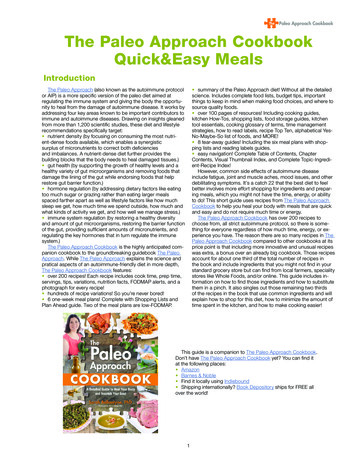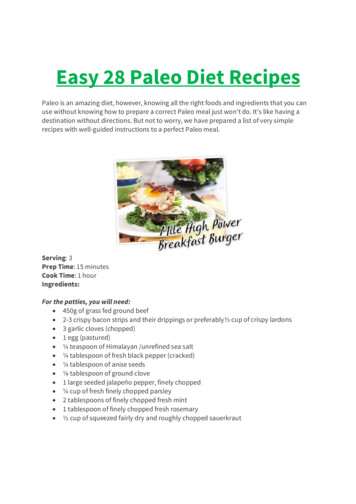
Transcription
RENEW FOOD PLANComprehensive GuideVersion 2
Table of ContentsWhat is the “ReNew Food Plan”?. 3Why ReNew?. 4Features of ReNew Food Plan. 5Touring Through theReNew Food Plan. 17Preparing for theReNew Food Plan. 24Frequently Asked Questions. 25Resources and Tools for Success. 28 2016 The Institute for Functional Medicine
What is the “ReNew Food Plan”?The ReNew Food Plan prescribed by a Functional Medicine practitioner is a therapeutic, short-term approachfollowed for a specific amount of time, often used as a first step in:nRidding the body of the most common foods that cause inflammationnIdentifying food allergies, sensitivities, intolerances, and triggersnEliminating foods with potentially addictive and harmful componentsnProviding nutritional support for the body’s detoxification systemsThe following questions may help to determine if the ReNew Food Plan is right for an individual:nDo you routinely consume and crave fast food, packaged foods, and processed foods withsugar or flour?nDo you consume fish or shellfish regularly? If so, what kind and where does it come from?nDo you regularly eat fruits and vegetables that are nonorganic?nDo you eat fewer than five servings of fresh fruits or vegetables per day?nDo you consume lots of animal products every day (e.g., meat, milk, cheese, and eggs)?If a person answers “yes” to one or more of the questions above, he or she may have an addiction to sugar orprocessed foods, may be exposed to a high level of potential food triggers or allergens, or may have a high totalbody burden of toxins. The ReNew Food Plan focuses on removing processed foods with sugar, grains, and dairy—the main sources of most food allergies and intolerances (also referred to as food sensitivities)—as well as artificialsweeteners and processed chemicals. As a result of eliminating these foods and chemicals from the diet, the bodywill be better able to repair tissues and eliminate toxins.A Functional Medicine practitioner may also suggest a gut restoration or healing program for patients who presentwith intestinal permeability (leaky gut). In this stage of healing, an assessment of digestive function may identifysources of gut bacteria or pathogens that create imbalances within the gut microbiome.IFMnReNew Food Plan Comprehensive Guide 2016 The Institute for Functional Medicine3
What is the “ReNew Food Plan”?One of the most important aspects of the ReNew Food Plan is the emphasis on consistent intake of foods thathelp optimize function of the primary organs of elimination and reduce stimulation of the immune system. The gutneeds to work efficiently to provide one to two well-formed bowel movements daily. Without proper movement ofthe bowels, fewer toxins are excreted from the body. Some of these excreted toxins are processed by the liver and arereleased through the bile. Adequate daily dietary fiber intake (at least 35 grams daily) from colorful, phytonutrientrich, non-starchy vegetables also aids in elimination of endotoxins in the stool. Some converted toxins are alsoeliminated through urine, which is why proper hydration is essential for optimal detoxification.The ReNew Food Plan is designed to support not just the gut, but also the liver, the hub of detoxificationprocesses. When neglected through lack of nutrients or overburdened by an increased toxic load, the liver’s capacityto detoxify becomes compromised. By implementing this food plan, an individual will decrease toxin intake andexperience better digestive function, improved immune function, and enhanced liver detoxification.Some individuals may need to follow this plan (or a variation of it) long term. A Functional Medicine practitionercan personalize the plan, advising individuals on how to add certain foods back into the diet while maintainingexclusion of others.Why ReNew?The ReNew Food Plan is a nutritional pathwayto health for those who have autoimmune,gastrointestinal, neurological, and other chronichealth conditions. This plan is designed as a “wholesystems reboot” to set an individual on a renewedpath to wellness. It helps support healing by removingcommon food triggers that are contributing tometabolic dysfunction while providing the essentialnutrients that are needed for health and vitality. TheReNew Food Plan is a way of eating that reducesintake of all sweeteners and processed foods, lowersinflammation, and improves the body’s ability toeliminate harmful substances. It places a strongemphasis on eating clean foods for life and avoidingthose foods that impair the body’s ability tofunction properly.The path to health and wellness is not a sprint, butrather a journey. This Comprehensive Guide supportsan individual’s journey in following the ReNew FoodPlan by providing tips on how to get started, what toeat, what to watch for, and how to provide the bodywith the right nutrients for improved utilization,elimination, and detoxification.IFMnReNew Food Plan Comprehensive Guide 2016 The Institute for Functional Medicine4
Features of ReNew Food PlannThe term detoxification has beencommonly used to refer to the process of withdrawing or “detoxifying”from recreational or prescription drugs, or from alcohol use. Morerecently, the meaning has expanded to include withdrawal ordetoxification from unhealthy or addictive foods.Supports Sugar Detoxification:When used in the context of functional medicine, the term “detox”refers to the physiological process of rendering chemicals, compounds,hormones, and toxicants less harmful, allowing the body to achieveoptimal health. This is often referred to as “metabolic detoxification”.The organs involved in detoxification work together efficiently toreduce the total body burden of toxins through elimination by theliver, kidneys, large intestine, lymphatic system, lungs, and sweat glands.On the ReNew Food Plan, detoxification is supported by eliminatingsugar, dairy, gluten, grains, alcohol, caffeine, and other processed foods that may contain heavy metals, geneticallymodified organisms (GMOs), and artificial sweeteners, as well as foods that are high in pro-inflammatorysaturated animal fats. By removing these components from the diet, thereby reducing environmental exposure tochemicals, the body is better able to convert toxins stored in fat cells into chemical compounds that are easier toeliminate via the urine or stool.Most people are unaware of the addictive nature of sugar-containing foods. Sugar-laden foods can promptovereating and weight gain, and they increase our risk of developing chronic conditions like diabetes and heartdisease. How did we become sugar addicts? Part of the blame lies with the food industry for using intensesweeteners in most of the processed convenience foods that many people consume daily. Highly-sweetened foodsactivate the ‘feel good’ receptors in the brain, much like addictive drugs. Constantly eating these foods raises bloodsugar, which perpetuates the vicious cycle of food cravings. In fact, recent research has shown that sugar is eighttimes as addictive as cocaine! Other research has indicated that calories derived from sugar are more easily convertedinto belly fat compared with the calories from protein, fat, or non-starchy carbohydrates such as leafy greens.It is important to understand why it is so essential to remove sugars (including artificial sweeteners) and processedchemicals from our bodies. One of those reasons is that prolonged consumption of these sugars and chemicalscan alter brain chemistry. When we eat sugar-containing processed foods often, we get a rush of dopamine—aneurotransmitter associated with desire and pleasure. A constant barrage of dopamine dulls the dopaminereceptors, which leads to an increased need for more and more of the addictive sugar to generate the sameamount of pleasure over time. This increased need is called tolerance, and it explains why an occasional drinkermight feel significant effects from a single alcoholic beverage, while a heavy drinker or an alcoholic may needseveral beverages to feel the same effect. Increased sugar tolerance has also been associated with an increased riskof depression, another major health concern.Evidence also shows a clear association between excessive sugar consumption and risk of obesity, type 2diabetes, cancer, and heart disease, as well as many other chronic diseases. In addition to these diseases, onecould have ‘cardiometabolic syndrome’ —a metabolic dysfunction with a constellation of symptoms includingabdominal obesity, elevated cholesterol & triglycerides, high blood pressure, high blood sugar, low-grade systemicinflammation, and an increased tendency to form blood clots.IFMnReNew Food Plan Comprehensive Guide 2016 The Institute for Functional Medicine5
Features of ReNew Food PlanWhile the dangers of consuming sugar and artificial sweeteners in excess are clear, removingthem from the diet can be challenging because of their biologically addictive nature. Themost effective way to put an end to sugar cravings is to replace all of the sugar and processedfoods in the diet with nutrient-dense, whole foods that come from the ground or an animal.The ReNew Food Plan is designed to help reprogram an individual’s biology and end thevicious cycle of processed food addiction.Examples of refined sugars, natural sweeteners, and artificial sweeteners—all of which are excluded on the ReNew Food Plan—are listed in the table below.Table 1. Refined Sugars, Natural Sweeteners, and Artificial SweetenersRefined SugarsNatural SweetenersArtificial SweetenersAgave, agave nectarDatesAcesulfameCane juice, cane sugarHoneyAdvantameCaramelMaple syrupAspartameDextroseSorghum itolInvert sugarYacon rinovaMolassesSaccharinSucroseSplendaSugar (brown, coconut,date, granulated, raw,turbinado, white, etc.)SucraloseSyrup (brown rice, cane,corn, flavored, etc.)Sweet’N LowSweetmyxTruviaTwinsweetXylitolIFMnReNew Food Plan Comprehensive Guide 2016 The Institute for Functional Medicine6
Features of ReNew Food PlanThe ReNew Food Plan will help detoxify the body from sugar and enhance overall health by:nDecreasing sugar cravingsnProviding nutritional support for the facilitation of toxinprocessing and excretionnnResetting compromised metabolismnDecreasing chronic pain and fatigue levelsnEnhancing weight lossnImproving cognitive function and moodnCreating more effective and satisfying sleep cyclesnImproving one’s sense of wellbeingEliminates Processed Foods: The industrial revolution made food more accessible, moreaffordable, and in some cases, more nutritious with the fortification of certain foods. As a result,the incidence of malnourishment and macronutrient deficiencies plummeted.During the industrial revolution, the food industry’s goal was to make food affordable andaccessible. However, now the goal seems to be to create products that influence consumers’ tastebuds and keep people coming back for more. Heat-and-eat boxed meals, microwavable frozenmeals, drive-thru meals, as well as snack foods like chips, cakes, and donuts, are inexpensive andconvenient, often taking little to no time to prepare. For many busy individuals and families,these products have become the primary sources of food—even in places where fresh foods arewidely available—because of the minimal effort involved in preparing them. Further, healthclaims in packaging have created confusion for consumers. While convenient, these foods aregenerally made from low-quality ingredients that offer little to no nutritional value. Sugars areoften added as a preservative to extend shelf life. Even foods that are not generally thought tobe sweet—like pre-made sausages or pasta sauce—often contain added sugar. This sets the stagefor sugar addiction, because many people don’t realize they are consuming the sugar hidden inthese processed foods.For our purposes, processed foods are defined as packaged foods with more than fiveingredients—including common allergens, additives, preservatives, chemicals, dyes, thickeners,and flavorings like MSG, salt, sugar, and fat. These processed foods are made from combinationsof unprocessed, minimally processed, and processed food ingredients and are designed withconvenience, rather than nutrition, in mind. Often, these foods are portable and can be eatenanywhere, requiring little to no preparation. Processed foods are often high in trans (partiallyhydrogenated) fats. These fats oxidize in the body, causing cellular damage. Antioxidants found infresh fruits and vegetables can block or reverse the process of oxidation, but without these foodsin the diet, oxidized fats can lead to inflammation and nutrient deficiencies.IFMnReNew Food Plan Comprehensive Guide 2016 The Institute for Functional Medicine7
Features of ReNew Food PlanMost processed foods—even those advertised as fortified with vitamins and nutrients—offerlimited nutritional value when compared with whole, fresh foods. In the United States, somefood manufacturers use fortification as a selling point for processed foods of questionablenutritional value—including candy, snacks, and sweetened breakfast cereals. Research suggeststhat the synthetic forms of vitamins added to processed foods do not offer the same nutritionalbenefits as vitamins that occur naturally in food.Examples of common processed foods—all of which are excluded on theReNew Food Plan—are listed in the table below.Table 2. Common Processed FoodsFood CategoryExamples of Processed FoodsGrains andgrain-based productsBreads, bagels, cakes, cereal, cereal bars, cookies,crackers, granola bars, muffins, pastas, pies, pizza, pretzels,rice and flavored rice mixes, tortillasDairy productsCheese (any), ice cream, sour cream, yogurtVegetable-based productsChips (potato, corn, tortilla, etc.), margarineMeat productsCanned meats, cured meats, salted meats, andsmoked meats (e.g., bacon, canned tuna, hot dogs,and sausages)Vegetarian and veganmeat replacement productsSeitan, textured vegetable protein (TVP), veggie burgersBoxed and canned mealsCanned chili, canned soups, frozen meals (diet andregular), shelf-stable dinner kitsSnacksCandy, candy bars, dips, fruit-flavored gummy snacks,sweetened trail mixBeveragesBottled teas, fruit-flavored water, fruit juice blends,soft drinks, sports drinksStore-bought condimentsBBQ sauce, chili sauce, chutney, duck sauce, jams,jellies, ketchup, liquid smoke, marinades (shelf-stable),marmalade, mayonnaise, mustard (flavored), pastasauces, preserves, relish, salad dressings, salsa, sauces(especially pre-made, shelf-stable), steak sauce, syrups,tartar sauceHerbs, spices, and otherBouillon cubes, flavored seasoning packets, gravy mixes,spice blendsWhen it comes to processed foods, a couple of good rules of thumb to follow are found inMichael Pollan’s books In Defense of Food: An Eater’s Manifesto and Food Rules: An Eater’s Manual:IFMnnDon’t eat anything that is incapable of rotting.nIf it came from a plant, eat it; if it was made in a plant, don’t.ReNew Food Plan Comprehensive Guide 2016 The Institute for Functional Medicine8
Features of ReNew Food PlanIn the ReNew Food Plan, processed foods do not include minimally processed orpreserved foods like canned or frozen vegetables, or sauces and soups made with only oneor two ingredients. These foods retain most of their nutritional value, and their ingredientsare recognizable, containing minimal to no added preservatives or flavorings. Examples ofthese foods are frozen green beans, canned tomatoes, and fermented foods like sauerkraut.While whole, fresh, organic foods are optimal, cost and access may make it difficult toobtain fresh produce all the time.nBecause of their frequentassociation with adverse food reactions, dairy products areomitted from the ReNew Food Plan. Some of the troublewith dairy is due to the presence of lactose, a milk sugar. Thelactose present in fresh milk and in many other commerciallyavailable dairy products can cause painful gas, bloating, anddigestive upset, especially for those who lack adequate lactase,the enzyme needed to properly digest lactose. It is estimatedthat somewhere between 25% and 90% of the world’spopulation is lactase-deficient.Dairy-, Grain-, and Gluten-Free:Fermented dairy products like yogurt and sour cream arelargely free of lactose, but these products contain casein, a milkprotein that can also cause adverse reactions. There are differenttypes of casein (A1 and A2 beta casein) in milk, depending onthe type of cow (e.g., Holstein, Jersey, or Guernsey), and this too may impact tolerance.Some people who cannot tolerate A1 beta casein have no problem with A2 beta casein.However, researchers are continuing to investigate the role these casein proteins play inallergies, intolerances, and leaky gut. Until science clarifies the debate surrounding thedifferent types of casein, the ReNew Food Plan eliminates all dairy products.Gluten is a sticky, water-soluble family of proteins found in a few key grains (barley,rye, and wheat) and associated grain products (breads, cereals, crackers, pastas, etc.), allof which are omitted from the ReNew Food Plan. Gluten is also commonly found invarious sauces, dressings, seasonings, and many other foods. Toxic proteins in gluten calledgliadins can break down the microvilli (finger-like protrusions of intestinal cells) in thesmall intestine. This deterioration causes leaky gut, which can cause (and also be causedby) food allergies, sensitivities, or intolerances, as well as other digestive disturbances orautoimmune conditions. Some people respond well after gluten is removed from thediet, even in the absence of the usual gastrointestinal symptoms associated with glutenintolerance. A growing body of evidence links gluten exposure to neurological symptomsincluding depression, fatigue, migraines, and brain fog, which may seem to be unrelated tofood intake. However, given that many neurotransmitters are produced in the gut, the linkbetween overall gut health and brain health is undeniable.IFMnReNew Food Plan Comprehensive Guide 2016 The Institute for Functional Medicine9
Features of ReNew Food PlanFor many people, going gluten-free is not enough, especially with a growing number of glutenfree convenience foods now readily available. These foods—muffins, brownies, cake mixes,etc.—are often filled with substitutes and additives like corn, potato starch, and gums than canbe just as damaging to the body, especially when they are a regular part of the diet. Additionally,gluten-free grains like rice, corn, and oats have proteins similar to gliadin, and these proteins cancause problems in gastrointestinal tracts that are already damaged or inflamed. For this reason,removing all grains from the diet, regardless of gluten content, is an essential step in the ReNewpathway to restoring health.Many people don’t associate grains with symptoms of food intolerance because of the frequencywith which these foods are eaten. Repeated exposure to a trigger food can result in a chronicinflammatory response, which may be undetectable until the offending food is removed fromthe diet completely (usually for a few weeks) and later reintroduced. An acute or immediatereaction after reintroduction is a signal that the food causes an immune response in the body andthus should be eliminated from the diet for a longer period of time.Examples of dairy products and grains removed from this plan are shown in the table below.Note that all products containing these foods as ingredients are also excluded from the plan.Table 3. Dairy Products and Grains to ExcludeDairy ProductsGrains (gluten-containing)Grains (gluten-free)ButterBarleyAmaranthCheese (all)BulgarArrowrootHeavy creamOats*BuckwheatHalf and halfRyeCassavaIce creamSeitanMilletKefirTriticaleOats*MilkWheat (farro, kamut, spelt,and all other varieties)QuinoaSour creamRiceYogurtSorghumTapiocaWild rice*Oats, even those that are labeled as gluten-free, are often processed in the same facility as gluten-containing grains and can becomecontaminated with gluten during processing. Additionally, even certified gluten-free oats that are never exposed to gluten can causesymptoms in some patients with celiac disease and gluten intolerance, as the protein structure found in oats is similar to that of gliadin.For this reason, patients should follow their practitioner’s advice when reintroducing oats back into their diets.IFMnReNew Food Plan Comprehensive Guide 2016 The Institute for Functional Medicine10
Features of ReNew Food PlannA growing body of scientific research suggests a connection betweenmodern foods, inflammation, and autoimmune illnesses. Diseases that are epidemic incontemporary Western countries are rare or nonexistent in hunter-gatherer and less Westernizedsocieties. These diseases are linked to foods and food products made popular during the industrialera—including dairy products, refined cereals, refined vegetable oils, and fatty meats from animalsprevented from grazing. In fact, modern food processing techniques and the resulting productshave fundamentally altered critical nutritional characteristics of the human diet: glycemic load,fatty acid composition, macronutrient composition, micronutrient density, acid-base balance,sodium-potassium ratio, and fiber content.Reduces Inflammation:Many foods and chemicals can cause inflammation in the gut, and oncethe intestines are inflamed, absorption of nutrients is compromised.The intestinal lining becomes porous, which allows large particlesof undigested food to pass through the intestinal wall into thebloodstream. This intestinal permeability can lead to a host of problems,such as fatigue, depression, more food intolerances, irritable bowelsyndrome, autoimmune diseases, asthma, and many other conditions.Over time, inflammation subsides with the elimination of certainfoods—like gluten-containing grains, sweeteners, and dairy products—and the gut is able to heal,which means the immune system can begin to work properly again. This leads to an improvedimmune response to airborne contaminants and allergens, industrial contaminants, viruses,parasites, and bacteria—which means that individuals will be less affected by these toxins andinfections, making them sick less often.Another important point is that the intestinal lining is made of cells that replace themselvesapproximately every two to four days. This means that, in the span of a single week, every cell inthe intestinal lining is digested or sloughed off and a new cell grows to take its place. Removingfoods that cause inflammation from the diet makes this newly formed gut tissue stronger andhealthier. Thus, it is important not only to remove potentially harmful foods from the diet,but also to supply the body with healthy, anti-inflammatory whole foods—especially thosecontaining healthy fats, fiber, and an array of phytonutrients.nIFMIdentifies and Reduces Food Triggers: Symptoms that have failed to respond to conventionalmedical therapy may resolve when a person follows the ReNew Food Plan. This plan can helppatients identify any foods that may be connected to health concerns. Many people with foodsensitivities don’t realize how bad they feel, or that particular foods are the culprit, until thefoods that trigger a reaction are removed from the diet. Food reactions are frequently overlookedas a contributor to chronic health issues. Some reactions are considered to be food allergies,meaning they cause severe symptoms immediately after a trigger food is eaten. Some reactionsmay be delayed by hours or even days; this type of adverse food reaction is referred to as a foodsensitivity. Food sensitivities are usually the result of an imbalance in the gastrointestinal systemthat affects the immune system. Food intolerances are reactions to certain food chemicals(e.g., lactose, MSG, histamines, etc.) that occur when a person is lacking an enzyme or nutrient,resulting in an inability to properly metabolize certain foods.nReNew Food Plan Comprehensive Guide 2016 The Institute for Functional Medicine11
Features of ReNew Food PlanRemoving the specific foods that cause adverse food reactions will allow the gut to heal,while simultaneously supporting detoxification pathways. Common food triggers areminimized or eliminated on the ReNew Food Plan, while nutrient-dense foods are includedto support detoxification and gut health. As a person follows the ReNew Food Plan, it willbecome clearer which trigger foods should be avoided and for how long.After completion of the ReNew Food Plan, a practitioner may suggest a personalizedfood reintroduction process for some patients. The goal is to expand the variety of healthyfoods available to an individual for daily intake, not to maintain a long-term restrictive diet.Reintroduction involves adding back one food at a time and observing whether that foodis associated with symptoms. Foods that continue to provoke symptoms (physical, mental,and emotional) are avoided until they no longer cause symptoms. Once the gut is healed,many foods that initially caused sensitivities may be reintroduced into a meal plan withoutsymptoms. In the later stage of food reintroduction, the goal is to diversify the diet foroptimal gut health. Eating the same handful of foods day after day does not provide thebody with an array of phytonutrients, which is important for overall health and is especiallyimportant for those who have gut permeability issues.nThe ReNew Food Plan is not about feelingdeprived! The nutrient-dense foods that make up the plan were all chosen for their abilityto balance blood sugar and hormone levels, which in turn will reduce cravings for highlyprocessed foods.Reduces Cravings and Food Addictions:In addition to eating three balanced meals that contain lean protein,healthy fats, and low-glycemic carbohydrates, individuals may includeup to two snacks per day to maintain blood sugar levels, if necessary.At least 10 –12 servings of non-starchy vegetables should be consumedto help boost and support detox pathways. Healthy fats like organicghee (clarified butter) from grass-fed cows, cold-pressed extra virginolive oil, coconut butter, and coconut oil help balance blood sugar,which in turn reduces sugar cravings and promotes feelings of satiety.Those whose previous diets were high in sugar, alcohol, or caffeine may face the greatestchallenges when beginning the ReNew Food Plan. Some negative symptoms can occur,usually only in the first 3 to 4 days, and may include the following:nHeadaches, especially migrainesnBrain fognFlu-like symptomsnIrritabilitynDifficulty sleepingAfter the initial detox period, patients following the ReNew food plan usually experience improved cognitionand mood, decreased pain and fatigue levels, improved sleep quality, and favorable changes in body weight.IFMnReNew Food Plan Comprehensive Guide 2016 The Institute for Functional Medicine12
Features of ReNew Food PlanTips for alleviating negative symptoms related to sugar detoxificationand processed food addiction include:nnStaying well-hydratednTaking a detox bath with Epsom salts and lavender oilnPracticing relaxation techniques such as mindful breathing or meditationnSpending time in a sauna or floatation therapy tankPhytonutrients to Heal the Gut: TheReNew Food Plan contains a broadvariety of colorful vegetables and fruits. These plant-based foods provide acomplex array of essential nutrients, called phytonutrients and antioxidants,that promote healing and detoxification in the gut, liver, and kidney. Theseplant-based antioxidants provide protection against free radicals that often formduring detoxification. Plant foods help alkalinize the body, improving excretionof toxins by the kidneys. Phytonutrients also play an active role in improvingthe stress response and reducing inflammation.Fresh fruits, while high in colorful phytonutrients, are higher in natural sugar, so only specifictypes and amounts are included in the ReNew Food Plan. In general, our taste buds are moreresponsive to sweet foods, which often results in eating more fruits than vegetables. The focusof this food plan is on incorporating more vegetables than fruits in the diet in order to avoidexcessive intake of natural sugars.nEncourages Healthy Elimination of Toxins: Whilethere is great emphasis in this food plan onreducing the intake of toxins of all kinds, the elimination of accumulated toxins present in the bodyis equally important. Several metabolic pathways in the body are responsible for converting toxinsinto chemical compounds, allowing toxin elimination primarily through urine, stool, and sweat.Many different nutrients are required to fuel the process of detoxification. A shortage or deficiencyof any one of them could result in an increased toxic load or toxic burden. Lowering the body’stoxic burden by eating clean, whole foods will assist the liver in converting toxins stored in thebody’s fat cells into intermediate metabolites that can then be excreted through the urine andstool. Intake of high-fiber foods with adequate hydration is essential to ensure elimination of thesetransformed toxins.A person’s toxic burden is a result of three main factors:nnnIFMnGenetics: predisposition for effective production of detoxification enzymes needed to processtoxic compounds or substrates is unique and depends on familial influence.Toxins: exposure can occur through both internal and external sources.Diet: a diet rich in detoxi fication nutrients and phytonutrients will promote the body’s abilityto eliminate toxic substances.ReNew Food Plan Comprehensive Guide 2016 The Institute for Functional Medicine13
Features of ReNew Food PlanSources of toxins that can increase the body burden include materials used in new construction, carpet chemicals,paint, household cle
IFM ReNew Food Plan Comprehensive Guide 6 Features of ReNew Food Plan 2016 The Institute for Functional Medicine While the dangers of consuming sugar and artificial sweeteners in excess are clear, removing them from the diet can be challe










